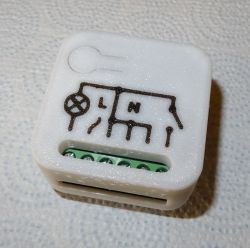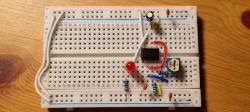FAQ
TL;DR: One Propeller-Clock rotor spins 50 rps (≈3 000 rpm) while an ATmega32 drives 32 LEDs; “in spectral clocks the issue of software … can make a difference” [Elektroda, Twizzter, post #4815839] Size, speed and code tweaks decide image quality. Why it matters: these tips prevent the common “00:00:80” bug and burnt HDD motors.
Quick Facts
• Rotor speed: 45-55 rps recommended to avoid flicker [Elektroda, mb1988, post #4814890]
• Power draw: 5 V / 250 mA (motor), 12 V / 80 mA (LEDs) [Elektroda, mb1988, post #4816959]
• LED count: 32 SMD on radius = 63 pixels diameter [Elektroda, mb1988, post #4815891]
• Motor driver: Philips TDA5140A; drop-in LB1688 works with minor tuning [Elektroda, mb1988, post #4815034]
• Typical build cost: PLN 50–60 for electronics; case from scrap plexi [Elektroda, mb1988, post #4816863]
How do I wire and start an HDD spindle motor for a propeller clock?
Use a three-phase BLDC driver such as TDA5140A in the page-9 reference design; tie the three windings to MOT1-MOT3 and create an artificial center if the drive is delta-connected [Elektroda, mb1988, post #4815034] Feed 5–6 V to VLOGIC and 5–12 V to VMOT while monitoring temperature.
Why does my DS1307 show 00:00:80 instead of real time?
Bit 7 of the seconds register (CH) is still high; the oscillator is halted. Clear CH once, then save time. Many builders forget the pull-up on SQW, causing the same symptom [Elektroda, mb1988, post #7122854]
What fuse settings are needed on the ATmega32?
Enable external 16 MHz crystal, start-up 16K CK+65 ms, CKOPT unprogrammed. Leave JTAGEN off to free PORT C pins. Wrong fuses keep INT0 from firing and the display stays blank [Elektroda, hetm4n, post #12007461]
How can I balance the spinning PCB without special tools?
Screw the board firmly to the motor hub, then eyeball component placement symmetrically. If vibration persists, add small blobs of epoxy opposite heavy parts until the wobble stops [Elektroda, mb1988, post #4815891]
What’s the simplest way to set or change time?
- Compile firmware with the desired compile-time constant (e.g., 12:00). 2. Flash it exactly at that wall-clock moment. 3. Immediately flash the normal firmware that leaves RTC untouched. This two-step trick was used by the original author [Elektroda, mb1988, post #4817605]
Can I replace the 8-bit MBI5170 LED drivers?
Yes. Any constant-current shift register (e.g., STP08DP05, 74HC595 + resistors) works if you adjust SPI width in code. One builder ran three ST16CP05 without issues [Elektroda, Scyzor, post #7800620]
My image drifts; how do I sync display to speed?
Reset TIMER1 on each opto-interrupt, divide the measured period by 240, load that into TIMER0; update LEDs in the TIMER0 ISR. If drift persists, lower the prescaler so division error stays <0.5 µs [Elektroda, mb1988, post #4815891]
What causes a missing wedge or duplicate sector in the graphics?
Integer rounding of TCNT1/RESOLUTION leaves residue; the wedge shifts with RPM. Use 32-bit math or accumulate fractional ticks (phase accumulator) to eliminate the gap [Elektroda, Pawełmatrix, post #4820097]
How do I convert bitmaps or GIF frames to the 960-byte frame table?
Crop a 63 × 63 monochrome bitmap, iterate every 1.5°, sample radius 0-31, and store four bytes per ray (240 steps × 4 = 960 bytes). Community GUI converters are shared in the thread [Elektroda, boxochi, post #17138028]
What’s a safe current for the SMD LEDs?
Set the MBI constant-current to 20–25 mA; with 50 rps the duty cycle is ~0.4 %, so average LED current stays below 100 µA, preventing thermal stress [MBI datasheet].
Edge case: my motor only starts if I spin it by hand—fixes?
Increase VMOT to 7–9 V, swap two phase wires, and check that CAP-CD/CAP-DC pins have the exact values (22 nF chosen wrong cuts starting torque) [Elektroda, Moyshaa, post #9075908]
Can I power the board contact-less to avoid worn brushes?
Yes. Wind a 3-turn primary under the plexi base and a 6-turn secondary on the rotor; resonate near 35 kHz. Keep coils 5 mm above the aluminum hub to curb eddy-current heating [Elektroda, mlassota, post #7122363]
Step-by-step: flashing firmware and storing graphics
- Flash boot HEX with CH cleared. 2. Flash main HEX. 3. Use the provided PC tool to convert BMP/GIF to EEPROM HEX, then flash EEPROM. Done.
What’s the expected lifetime of the brushes?
Copper ring runs for 1–2 years at 50 rps before visible wear; lowering speed to 25 rps triples life, according to a 10-year user report [Elektroda, hetm4n, post #19746865]





